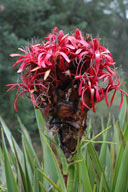In Flower This Week
A news sheet prepared by a Gardens' volunteer.
Numbers before each plant refer to temporary IFTW labels in the gardens.
Numbers in square brackets [ ] refer to garden bed Sections. Plants in flower are in bold type.
View past issues of 'In Flower This Week'.
12 November 2014
Doryanthes excelsa click for larger image |
We will walk to the Rock Garden today, as there are many choice plants in flower there.
- Walk up the road past the café until you see the sign to the Rock Garden. On your left as you turn right is Doryanthes palmeri [Section 114] or Giant Spear Lily. This plant has a spectacular flower-spike. The huge nodding cluster of bright red flowers is much-visited by Wattlebirds and other honeyeaters. The plant grows in a rosette and the leaves can reach the length of about 3 metres. The flower spike may reach up to 5 metres.
- Enter the Rock Garden up the steps to see on your right Doryanthes excelsa, or Gymea Lily [Section 15d]. This plant is indigenous to the coastal areas of New South Wales near Sydney. It has sword-like leaves more than a metre long and flower spikes 2-4 metres high.
- Also on your right in a pot is Hibbertia pedunculata [Section 15d], with bright yellow flowers on fine creeping foliage. The species name ‘pedunculata’ refers to the long peduncle or stalk of each flower.
- Further on your right is Grevillea ‘Poorinda Royal Mantle’ [Section 15d], with red toothbrush flowers on a vigorous sprawling groundcover.
- As you continue up the hill on your left is Leptospermum variabile [Section 15c], a large shrub with many branches, small leaves and numerous white ‘tea-tree’ flowers. This plant is native to northern New South Wales and Queensland.
- Look to your left to see Eremaea pauciflora var. pauciflora [Section 15b], a small sprawling shrub with orange flowers. It grown naturally in southwest Western Australia.
- Notice on your left Viola hederacea [Section 15a], a small mauve and white violet on a close groundcover. It is common and widespread in Victoria and Tasmania, along the Great Dividing Range in New South Wales, in the far south-east of South Australia, and in a small area of the Adelaide Hills.
- Turn right, then right again to see on your right Verticordia galeata [Section 15f] with small bright yellow honey-scented flowers in profusion. It is found naturally near Geraldton, Western Australia.
- Turn left across the plank bridge to see in a pot on your left Olearia megalophylla [Section 15m]. Its white daisy flower-heads have yellow centres and are strongly scented. The large leaves are dark green above and woolly underneath. The plant is native to southern New South Wales and Victoria.
- Turn right down the hill to see on your right Leptospermum jingera [Section 15q], a large bush with drooping branches and white flowers that is endemic to Victoria.
- On your right is Prostanthera hirtula [Section 15q], a white-flowered Mint Bush with small greyish leaves, found naturally in New South Wales and Victoria.
- Go down the steps, then turn left up the other flight of steps to see on your right Eremophila bignoniiflora x polyclada [Section 15r]. This hybrid has large white bell-flowers with purple spots on an open linear-leaved shrub.
- On the right is Alyogyne ‘West Coast Gem’ [Section 15r], with clear purple ‘hibiscus’-type flowers which open for a short period only but are prolific. The bush is medium-sized with coarse foliage.
- Also on the right is Labichea lanceolata subsp. lanceolata [Section 15r], a large bush with bright green foliage and yellow flowers with a red throat. It is found naturally in south-west Western Australia, named after Jean Jacques Labiche (1748–1819), a second lieutenant on Freycinet's 1817-20 voyage around the world.
- Also on your right in a pot is Darwinia oxylepis [Section 15r], with dainty green foliage and pink bell-flowers.
Rosalind Walcott
![Director of National Parks [logo]](../../../../images/dnp_90px.gif)







